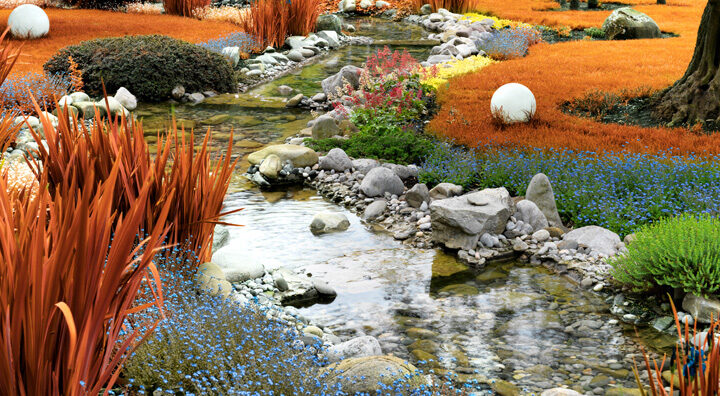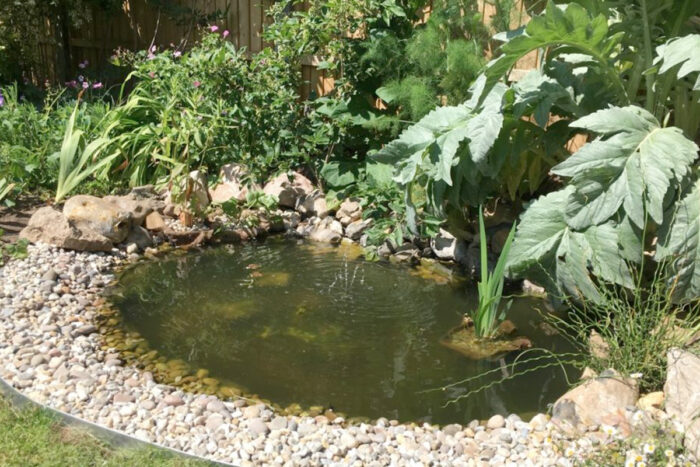
The cooler months can be a challenging time for your garden and plants and the same applies to your pond.
Here are our top tips for perfect winter water features.
Just like your garden, a little care for your pond will keep it looking gorgeous over winter and leave it ready to splash back to life come spring.
Plants
The majority of pond plants are warm season perennials – they live for many years but become dormant through the cooler months. This means that during winter they will start to look very tired and shaggy, often with dead leaves and old flower heads. In very cold areas you may even find that the foliage dies back completely leaving somewhat dead or bare looking plants. There are two things you need to do to keep your water feature looking great.
Prune and tidy – Remove all of those old daggy and damaged leaves and any spent flower heads. If there is still reasonable quality foliage on your plants leave that for now but do be aware it will continue to die-back slowly as spring approaches and new seasons leaves arise.
Lift, divide, re-pot – The approach you take here will vary a little on how you are growing your pond plants – in containers or in the gravel in the pond bed.
Just as you would with warm season garden perennial plants, winter is the time to lift and divide your pond plants. If plants such as aquatic iris or pickerel rush have outgrown their containers or have spread through the pond bed they may need to be cut before lifting as they will be bulky and heavy. You will often find that they will naturally break as you lift them anyway. That’s okay as you’ll do that as you divide them up.
Remove them from their containers and remove excess soil or growing material. You’ll see most have long, thick, root-like structures, these are called rhizomes. Tropical waterlilies have more of root cluster, a corm. You’ll notice that some areas are obviously dead, remove these sections with a sharp garden knife, aiming to leave a section that has a couple of older leaves (or leaf stems) and shows signs of next seasons new buds and fresh roots.
These are the parts you want to repot or replant.
Plant into AQUAPRO Planting Baskets. These have been purpose designed for pond plants and are perforated all over to maximise the circulation of water and dissolved nutrients and oxygen around plant roots. Use a good quality conventional outdoor potting mix but avoid one with water crystals. Add mix to the base, then position plants and fill to around 30mm below the rim. Then add well-washed pebbles, gravel or very coarse sand to the top in a layer around 20mm thick. This anchors the plant and potting mix.
Water very, very thoroughly until the mix is saturated and the water running out is clear before putting back into the pond.
You can also add some specialised pond plant fertilisers tablets at this time too.
Sludge
This can naturally accumulate in your pond and during the warmer months shouldn’t cause too much of a problem. This is because all of the wonderful microorganisms in your pond feed on this material and convert it to useful nutrients that plants will take up. Three things happen in winter however – the cooler weather slows down metabolisms of those microorganisms so they consume less and the cooler weather also reduces their population; plants are not taking up those extra nutrients; there is extra leaf material falling into the pond from autumn through winter. All of this means you need to help your pond with its natural processes. There are a few easy ways to do this.
Keep it clean – Physically remove excess material falling into your pond as this is what will ultimately become sludge. You’ll find a plastic leaf rake with a small head can be useful for this but just watch you don’t catch any pump or lighting hoses and leads.
If you have an excess of sludge then a simple way to remove this is using an AQUAPRO Little Pond Sucker. This ingenious device fits on your garden hose and when the hose is turned on a natural ‘venturi’ action is created sucking up fine material as you move it along the pond bed. This is then discharged through a hose to garden areas.
Speed up the process – AQUAPRO Bio-natural Sludge Away is a blend of naturally occurring bacteria that work to dissolve pond sludge. Add at regular intervals through the cooler months to accelerate removal of sludge.
Population top-ups – Add a full range of fresh beneficial bacteria with probiotic products. This will top up and balance the populations of beneficial bacteria in the cold weather and the extra numbers help compensate for their slowed metabolisms. A super-easy way to do this is by adding AQUAPRO Booster Balls. They are a simple and safe way to add balanced populations of beneficial microbes.
Pump system
Now is the ideal time to be giving your pump and filter system a refresh. Pre-filter sponges, whether on-board or external, should be removed and carefully massaged to clean in a bucket of pond water. You need to use pond water as these filters are engineered to be ‘bio-filters’. Beneficial bacteria form populations in the sponges to help keep water clear and clean and if you wash the sponge too vigorously, such as flushing with a hose, or you use tap water that’s been treated with chlorine and other chemicals you will displace or kill these bacteria and new populations will need to establish.
If you haven’t replaced your pre-filter sponge for over 18-months then consider doing this now. If you only use the on-board filter sponge that came with your pump look at changing to an AQUAPRO External Pre-filter Sponge block for improved filtering performance and reduced strain on your pump.
Water quality
To look after your pond water at this time you need to keep on top of sludge issues but also cut back on feeding off fish. Fish activity slows in the cool seasons so they need to be feed less frequently and with lower quantities of food otherwise the food will settle and rot causing water quality problems. Now is also the ideal time to replace some of your pond water.
Taking care not to suck up any fish you can syphon off, or redirect your pond pump, to remove around 1/3 to 1/3 of the water and then replace with fresh tap water. When you add the fresh water it is very important that you also add AQUAPRO Pond Water Treatment & Conditioner to neutralise potentially harmful chemicals in the new pond water.
These easy steps will have your pond staying healthy and looking neat and tidy across winter and also set it up perfectly for spring.




